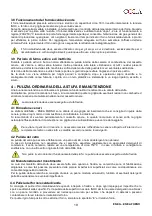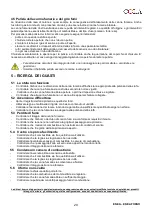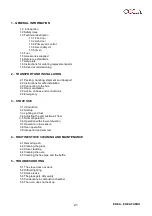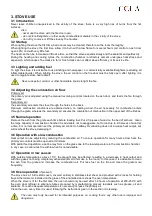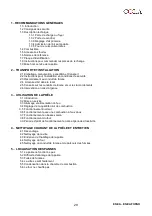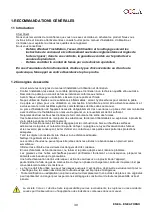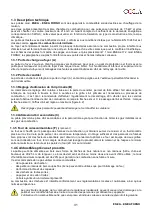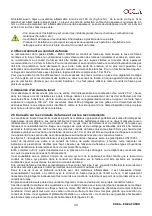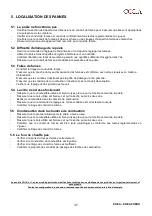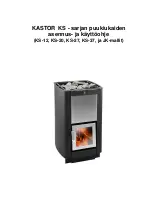
ENEA – ENEA FORNO
25
- An incorrectly installed stove can be the cause of serious accidents (flue, insulation materials, etc.,
catching fire).
- Do not store flammable material near the stove.
- Installation must be carried out, ensuring access for maintenance and cleaning the stove and flue.
2.3 Connection to the flue
The ENEA –
ENEA FORNO stove must be connected to the flue via the collar on the hotplate, using flue pipes that
are readily available on the market. Connection to the chimney must be made using strong and sturdy pipes of
recommended minimum thickness 1.2-2 mm. The flue pipe must possibly be straight, to avoid pressure losses, and
towards the flue. The ends of the flue pipe must be tight.
To ensure regular operation, the flue draught with stove operating must be between 10 and 14 Pa.
For maximum stove efficiency, a draught restrictor or damper should be installed in the flue pipe or chimney. Each
stove must eliminate the fumes through its own flue; never use the same flue for several units.
2.4 Room ventilation
The air necessary for combustion, i.e. up to 25 m³ every hour, must be ensured in rooms where stoves with natural
flue draught are installed. The air exchange must occur with at least one fixed opening to the outside, whose
section depends on the current local regulations and in any case must not be less than 100 cm2. Such openings
must be protected with grilles and must never be obstructed.
If the air is insufficient, even the operation of an extractor hood in the room can negatively affect stove operation.
2.5 Advice on flues and connections
Flues must be made from suitable materials and perfectly insulated, with characteristics that prevent temperature
decreases.
The inner walls must be perfectly smooth without any narrowing or protrusions along the entire length, so as not to
create friction or vortices in the smoke which could cause a considerable reduction in draught.
Any doors for cleaning and inspection must be perfectly closed during operation.
The flue outlets must be 0.5 m higher than any obstacles located less than 10 m away and must end with chimney
caps or cowls having a useful outlet cross section of at least double that of the flue.
Figures
1–
2
give the data regarding the distances and positioning of chimney caps in conformity with the
provisions of UNI 10683.
Before connecting the stove to an existing chimney, in addition to complying with that described above, make sure
there are no openings or cracks where air could enter and cause a temperature decrease affecting the draught.
Also make sure there are no obstructions caused by foreign bodies or a buildup of soot.
The first connection section leaving the stove should be vertical, whereas the flue connection to the chimney (which
goes to the chimney cap) must only enter by a few cm, so as not to reduce the cross section of the flue.
If the flue is not perpendicular to the chimney it is advisable to make the connection with special steel fittings that
allow a maximum slope of 45°.
If the walls and ceiling are made of flammable materials, the parts in contact with the flue must be suitably
insulated. All connection joints must be carefully sealed, in particular where the connection enters the flue.
If there are several heating cook stoves in the same home, each must have its own flue.
It is inadvisable to make openings in the flue for connecting other appliances, as this could affect the draught.
According to Standard UNI 7429, the chimney cap must meet several requirements; above all, it must have a
useful outlet cross section at least double that of the flue. It is also advisable to install an "antiwind" cap that
guarantees fume exhaust even in the presence of strong crosswinds (figures
3 –
4
).
2.6 Emergency
Suitable fire-prevention devices should be arranged for any eventuality.
In case of a fire, proceed as follows:
- Immediately close the loading door and the ash pan.
- Close the combustion air controls.
- Extinguish the fire using suitable fire-extinguishers.
- Call the fire department immediately.
- Do not use jets of waters to extinguish the fire.
Summary of Contents for ENEA
Page 4: ...ENEA ENEA FORNO 3 ...
Page 5: ...ENEA ENEA FORNO 4 ...
Page 6: ...ENEA ENEA FORNO 5 ...
Page 7: ...ENEA ENEA FORNO 6 ...
Page 8: ...ENEA ENEA FORNO 7 ...
Page 9: ...ENEA ENEA FORNO 8 ...
Page 11: ...ENEA ENEA FORNO 10 Presa d aria Air inlet Prise d air Lufteinlass Toma de aire 5 6 6 1 6 2 ...
Page 12: ...ENEA ENEA FORNO 11 7 1 ENEA 7 LAYOUT ...









